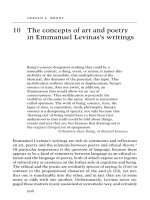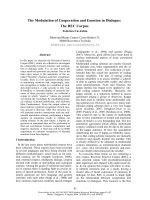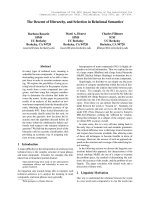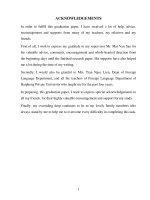THE REPRESENTATION OF PROTAGONISTS AND ANTAGONISTS IN MARVEL FILM POSTERS a MULTIMODAL DISCOURSE ANALYSIS = PHÂN TÍCH DIỄN NGÔN đa PHƯƠNG TIỆN về các THỂ HIỆN NHÂN vật CHÍNH DIỆN và PHẢN DIỆN TRONG áp PHÍCH PHIM MARVEL
Bạn đang xem bản rút gọn của tài liệu. Xem và tải ngay bản đầy đủ của tài liệu tại đây (8.45 MB, 62 trang )
VIETNAM NATIONAL UNIVERSITY, HANOI
UNIVERSITY OF LANGUAGES AND INTERNATIONAL STUDIES
FACULTY OF ENGLISH LANGUAGE TEACHER EDUCATION
FACULTY OF LINGUISTICS AND CULTURE OF
ENGLISH-SPEAKING COUNTRIES
GRADUATION PAPER
THE REPRESENTATION OF PROTAGONISTS
AND ANTAGONISTS IN MARVEL FILM
POSTERS: A MULTIMODAL DISCOURSE
ANALYSIS
Supervisor:
Student:
Course:
Nguyễn Thị Minh Tâm, Ph.D
Lê Thị Thu Uyên
QH2017.F1.E1.SPCLC
HÀ NỘI - 2021
ĐẠI HỌC QUỐC GIA HÀ NỘI
TRƯỜNG ĐẠI HỌC NGOẠI NGỮ
KHOA SƯ PHẠM TIẾNG ANH
KHOA NGƠN NGỮ VÀ VĂN HĨA CÁC NƯỚC NĨI TIẾNG ANH
KHĨA LUẬN TỐT NGHIỆP
PHÂN TÍCH DIỄN NGƠN ĐA PHƯƠNG TIỆN VỀ
CÁC THỂ HIỆN NHÂN VẬT CHÍNH DIỆN VÀ
PHẢN DIỆN TRONG ÁP PHÍCH PHIM MARVEL
Giáo viên hướng dẫn: Nguyễn Thị Minh Tâm, Ph.D
Sinh viên:
Lê Thị Thu Uyên
Khóa:
QH2017.F1.E1.SPCLC
HÀ NỘI - 2021
I hereby state that I: Le Thi Thu Uyen, class QH2017.F1.E1, being a candidate for
the degree of Bachelor of Arts (programme) accept the requirements of the College
relating to the retention and use of Bachelor’s Graduation Paper deposited in the
library.
In terms of these conditions, I agree that the origin of my paper deposited in the
library should be accessible for the purposes of study and research, in accordance
with the normal conditions established by the librarian for the care, loan or
reproduction of the paper.
Signature
Hanoi, May 4th, 2021
ACKNOWLEDGEMENTS
It has been a wonderful journey for me in completing this research and discovering
a lot about the subject and myself as well.
First and foremost, I would like to express my greatest gratitude to my supervisor,
Dr. Nguyen Thi Minh Tam. She has always been supportive and helpful. She is
always there when I am in need and opens up a lot of ideas for me to complete my
research. Had it not been for her devotion and encouragement, I would not have
had the persistence to finish this research.
Secondly, I would also want to thank my family and my friends, specifically by
boyfriend Truong Giang, by bestfriend In Hong and my Tichchu squad. My family
is always my ultimate source of motivation and support. My friends are no less
supportive and they also provided me a lot with their knowledge of the field in
which my study is based on.
Lastly, I would like to give credit to ULIS. All the knowledge and experience I
had here is priceless. Without ULIS, I would not have met so many dedicated
teachers and sincere friends that positively influenced me and helped me become
the person I am today.
i
ABSTRACT
This research examines the design of film posters employing multimodal analysis. Two
research questions were raised, one regarding the representation of lines of characters in
film posters, the other question examines how the films’ plots are tailored into the posters.
In order to answer these two questions, eight representative film posters were collected
from Marvel Cinematic Studios. The data was then analyzed based on the adapted version
of Kress and Leeuwen (2004)’s MDA framework. Both quantitative and qualitative
methods were employed in the analyzing process. The findings revealed that Marvel
Studio has significant features when illustrating its characters in posters, namely via
perspectives, gaze, frame size. The posters also contain many elements that help deliver
the synopsis of the film. These criteria not only reveal the circumstances of the film, but
also indicate the characters’ personality and status. Moreover, the design of the posters
also provokes heated conversations among Marvel fans on a plethora of social platforms,
which corresponds to the film studio’s marketing scheme that is to boost the film’s social
coverage and brand awareness.
Key words: Multimodality, Visual grammar, Marvel Film Poster
ii
LIST OF FIGURES, TABLES, AND ABBREVIATIONS
List of figures
Figure 1. Main types of visual representational structure (Kress & van Leeuwen, 2006,
p.59) ................................................................................................................................... 6
Figure 2. Interactive Meanings in Images (Kress & van Leeuwen, 2006, p.149) ............ 7
Figure 3. The interactive and compositional dimensions of visual grammar (Kress &
van Leeuwen, 2006) ........................................................................................................... 8
Figure 4.Analytical framework for MDA of Marvel Film poster .................................... 13
Figure 5. Distribution of portrayal of characters in Marvel film poster ........................ 14
Figure 6. Elements in the Micromodel of the Communications process (Kotler & Keller,
2016, p. 585) .................................................................................................................... 42
List of tables
Table 1. Three meanings in the clause (Halliday and Matthiessen, 2014, p.83) .............. 3
Table 2. Three strands of meta-functions in SFL and VG ................................................. 6
Table 3. Summary of the qualitative findings .................................................................. 15
Table 4. Representation of Characters............................................................................ 38
Table 5. Summary of elements delivering the film content.............................................. 40
List of abbreviation
SFL: Systemic Functional Linguistics
VG: Visual Grammar
MDA: Multimodal Discourse Analysis
iii
TABLE OF CONTENTS
ACKNOWLEDGEMENTS ............................................................................................................ i
ABSTRACT ................................................................................................................................... ii
LIST OF FIGURES, TABLES, AND ABBREVIATIONS ........................................................ iii
1.
2.
CHAPTER 1: INTRODUCTION ........................................................................................ 1
1.1.
Rationale and research questions ............................................................................. 1
1.2.
Scope of the study ....................................................................................................... 1
1.3.
Significance of the study ............................................................................................ 2
1.4.
Organization of the thesis .......................................................................................... 2
CHAPTER 2: LITERATURE REVIEW ............................................................................. 3
2.1.
Theoretical Background ............................................................................................ 3
2.1.1. Systemic Functional Linguistics .............................................................................. 3
2.1.2. Multimodal Discourse Analysis (MDA) .................................................................. 3
2.1.3. Film Poster as a subgenre of advertisement ............................................................. 9
3.
2.2.
Previous literature .................................................................................................... 10
2.3.
Chapter summary..................................................................................................... 11
CHAPTER 3: METHODOLOGY...................................................................................... 12
3.1.
Data collection........................................................................................................... 12
3.2.
Data analysis ............................................................................................................. 12
3.2.1. Methods of the study .............................................................................................. 12
3.2.2. Analytical framework ............................................................................................ 12
3.2.3. Data analysis procedure ......................................................................................... 13
4.
CHAPTER 4: FINDINGS AND DISCUSSION ............................................................... 14
4.1.
Findings ..................................................................................................................... 14
4.1.1. Statistical Findings ................................................................................................. 14
4.1.2. Qualitative Findings ............................................................................................... 15
4.2.
Discussion: Answers to the research questions...................................................... 38
4.2.1. Answering Research Question 1: “How protagonists and antagonists are
multimodally represented in Marvel film posters” ............................................................. 38
4.2.2. Answering Research Question 2: “How do Marvel’s film posters succinctly
address the contents of the films?” ..................................................................................... 40
5.
CHAPTER 5: CONCLUSION ........................................................................................... 43
5.1.
Summary of the main ideas.................................................................................... 43
5.2.
Implication ............................................................................................................. 44
5.3.
Limitations and suggestions of further research .................................................... 44
6.
REFERENCE .................................................................................................................... 45
7.
APPENDIX ........................................................................................................................ 47
1. CHAPTER 1: INTRODUCTION
1.1.
Rationale and research questions
In today’s age of electronic technology and media, communication is mostly depicted in
the form of visual images such as advertisements, flyers, leaflets, brochures, posters, etc.
Recently, posters are considered a preferable means of communication due to its
effectiveness in conveying messages. In the movie industry, the mission of the film
posters is not only introducing the upcoming films to the public, but also interacting with
the audience via the astute and creative synthesis of various semiotic elements.
Why Marvel
With technological development, discourse in posters is more complex than ever due to
the combination of various symbolic resources. Additionally, as audiences are rather
critical about the aesthetic and collection value of the objects presented in the poster, the
need to understand how each element affects the total comprehension of the text is crucial.
While interpreting the film posters through multimodal discourse, it is a viable research
question to find out:
(1) How protagonists and antagonists are multimodally represented in Marvel film
posters?
(2) How do Marvel’s film posters succinctly address the contents of the films?
1.2.
Scope of the study
The study collects eight films posters from Marvel Studio’s total of 24 posters which
depict heroes or supermen from 2008 and 2019. The represented participants in the
posters can be either the protagonist or the antagonist of the films. A multimodal discourse
analysis of these film posters was conducted to not only study the portrayal of lines of
characters in the films but also learn the way Marvel films’ content and context are
embroidered into the posters.
The collected data of the thesis are movie posters, which consists of more visual elements
than verbal texts. Therefore, the focal point of this study is put on the interpretation of
pictures instead of verbal elements. Putting the objective of the research into
consideration, only Kress and van Leeuwen (2006)’s framework of visual communication
was comprehensive enough to answer the questions presented. However, the researcher
has adjusted some features of Kress and van Leeuwen’s framework in order to better
analyze the targeted posters.
1
1.3.
Significance of the study
The study aims to investigate the way Marvel portrayed their heroes in their film posters
from a multimodal perspective and how this portrayal could contribute to the conveyance
of the film contents. The results of this research will contribute to the field of multimodal
research in the sense that it indicates the way film posters deliver the portrait of characters
and the connotation of movies. Accordingly, the research could serve as a reference for
designers or editors who wish to produce posters to attract and engage viewers.
1.4.
Organization of the thesis
The research content is organized into five following main parts:
Chapter 1 offers the Introduction by describing the rationale, objectives, scope and the
significance of the study then raising the research questions.
Chapter 2 explores Literature Review, which provides an overview of the relevant
literature on the issues of multimodality and posters, especially film posters.
Chapter 3 outlines the Methodology. The chapter gives a description of research methods,
data collection instruments, data collection procedures and data analysis procedure.
Chapter 4 reports the Findings and Discussions. In details, in this chapter, two research
questions are addressed and further discussed with analyzed data alongside the literature
introduced in Chapter 1.
Chapter 5 discusses the Conclusion by summarizing the main results of the study.
Limitations and implications for further studies are also included in this chapter.
2
2. CHAPTER 2: LITERATURE REVIEW
2.1.
Theoretical Background
2.1.1. Systemic Functional Linguistics
Systemic Functional Linguistics (hereafter SFL) is an approach to linguistics in which
language is considered a “social semiotic" system developed by the renowned linguist
Michael Halliday. According to Halliday (1978), “social semiotic” is a means to
distinguish linguistically language from its social context. For Halliday, language is a
means for generating meanings and the grammatical or the other aspects of language are
considered as sets of choices (Halliday & Matthiessen, 2014, p. 23).SFL can be described
as the connection between language and its function in the society. According to
Halliday’s theory on SFL, all languages are structured to conform three strands of
meanings simultaneously, which are ideational, interpersonal and textual (Halliday,
1973). Halliday and Matthiessen (2014) propose that the ideational meta-function refers
to the interpretation of human experience and the representation of the natural world. The
interpersonal meta-function deals with the relationship between the speaker and the
addresses, with a view to express feelings and attitudes. The textual meta-function
concerns the creation of text with the presentation of ideational and interpersonal
meanings as well as reveals the information structures and the organization of each
coherent part of the discourse to the whole and to the context (Halliday, 2003, p.351).
Having acknowledged that language is “social”, Halliday (2003) believed that the three
meta-functions are recognized through the clause – the smallest unit. The systems and the
organization of the analysis of the clause is summarized in the following table.
Table 1. Three meanings in the clause (Halliday and Matthiessen, 2014, p.83)
2.1.2. Multimodal Discourse Analysis (MDA)
2.1.2.1.
Multimodality
With the phenomenal development of technology and electronic media, most of the types
of communication that take place are multimodal. Influenced by Halliday’s continuous
development theory of SFL, Gunther Kress adapted Halliday’s theory to different means
3
of producing meaning and together with Theo van Leeuwen, coined the term
“multimodality” as “the analysis of composite or multimodal text comprises any text
whose meaning are realized through more than one semiotic code” (Kress & Leuuwen,
2006, p.117). Hence, meanings are no longer interpreted through a single semiotic
element but are constructed with the use of a plethora of semiotic codes or modes
affecting the composition as a whole integrating the meaning of its elements, which could
be text, pictures, graphics, layout, gesture, etc.”.
Although the term was firstly introduced in 1990s, many multimodal studies had been
conducted (Rowsell & Collier, 2017) and many researchers (Jewitt, Bezemer,
O’Halloran, Rodríguez, Velasco & Sánchez) had determined to give clearer definitions
to it. In 2013, Multimodality is defined as “the existence of multiple modes of
communication, in order to manage meaning construction through the effective
integration of a repertory of resources suited to the needs of different users" (Rodríguez,
Velasco & Sánchez, 2013, p.49). O’Halloran (2016) based on her proposed term “multisemiotic” to reveal the definitions of mode and modality, which refer to the channel of
communication. Supporting O’Halloran’s findings, Jewitt, Bezemer, O’Halloran (2016)
considered multimodality as the countless semiotic elements retrieved from different
resources such as typography, colors, etc. to identify the meaning potential in each
semiotic system.
To conclude, the method of merging several modes in a message to better convey the
meaning is referred to as “Multimodality”. According to Machin (2007), Multimodality
is a description of a grammar that is used visually with rules and structures that are
analyzed semiotically and have the potential to produce meaning. These potential
meanings are dependent on the context in which all the elements of the multimodal text
are allocated.
Regarding language as a social semiotic and meaning potential, SFL offers theoretical
ground to develop Multimodal Discourse Analysis (henceforth MDA). These days, there
has been an enormous increase in the number of extensive studies into multimodal
discourse on a plethora of semiotic features, namely written, published speech, websites,
films, images, paintings, magazines, 3D objects, and so on. MDA deals with how texts
employ modes of communication in alliance with words to generate meaning. MDA looks
at how multimodal texts are presented and how semiotic tools namely colors, focus,
framing and positioning of features attribute to the formation of meaning in these texts.
(Paltridge, 2012). Based on the intuition of Halliday’s (1978, 1985) social semiotic theory
4
of languages, researchers in the 1990s were particularly inspired with analyzing nonverbal semiotic resources namely displayed art (O’Toole 1994), visual design and
grammar (Kress & van Leeuwen 1996), mathematical symbolism (O’Halloran 1996,
1999a), and action (Martinec 1998). In order to multimodally analyze the text, several
frameworks have been introduced, in which two of the most prominent approaches are
O’Toole (1994)’s and Kress and Leeuwen’s (1996).
2.1.2.2.
Michael O’Toole’s approach
O’Toole (1994)’s The Language of Displayed Art is one of the most popular books about
Multimodality. O’Toole was influenced by Halliday’s SFL and adapted it in order to
analyze different modalities. He claimed Halliday’s framework to be “the only semiotic
model available that can bring together and theorize the relations between these three
dominant concerns of contemporary semiotics”, namely ideational, interpersonal and
textual meaning. O’Toole’s analysis of visual art (including one modern painting and one
contemporary building) also considered three universal functions that could be interpreted
through systems of representational, modal, and compositional choices.
In his framework, O’Toole (1994) analyzed the painting at different levels as can be seen
in the horizontal axis, a rank scale of units namely Picture, Episode, Figure, Member
(which is adapted from Alberti’s formulation) yet still similar to Halliday’s rank scale of
linguistics elements. However, the unit criteria to study architecture works is altered to
Building, Floor, Room and Element, which he found more useful to differ the rank-scale
of these systems. For the aesthetic “fine art of painting”, O’Toole (1994) decided to label
the functions as Representational, Modal and Compositional in order to confront
significant areas of debate in art while in examining the works of architecture, he
preserved Halliday’s functional labels as he believed that the use of linguistic function is
predominant.
2.1.2.3.
Kress and van Leeuwen’s approach
Kress and van Leeuwen put forth Halliday’s SFL so as to analyze other meaninggenerating elements such as sounds, images, color, gestures, framing (Hu & Luo, 2016).
This theory was first applied as a ground for MDA concurrently by Kress and Leeuwen
(2006)’s “Theory of Visual Communication” and “Reading Images – The grammar of
visual design”, which mainly interprets visual elements of discourse by analyzing
multiple modes simultaneously. They believe that the same semiotic system that applied
to language (verbal grammar) can also be applicable to the visual composition through
5
visual grammar. Kress and van Leeuwen applied Halliday’s theoretical notion of the three
meta-functions of language namely ideational, interpersonal and textual in illustrating
visual compositions, which are representational structure, interactive and compositional
respectively. The corresponding relation between three strands of meta-functions in
verbal grammar and visual grammar are illustrated below.
Table 2. Three strands of meta-functions in SFL and VG
Firstly, the ideational meta-function is visually realized by the representational structure.
It serves as the transitivity structure in verbal grammar, which acquires the ability to
represent objects and their relations in the world as it is experienced by humans (Kress &
Leeuwen, 2006). Two objects involved in a process of interaction could be visually
realized by either vectors or other structures (e.g. “tree” structure). And in order to present
aspects of the world, images are categorized into two types of structures: narrative and
conceptual. Both structures are realized through processes, participants and contexts,
which are identical with the transitivity structure in the ideational strands of meaning in
verbal grammar.
Figure 1. Main types of visual representational structure (Kress & van Leeuwen, 2006,
p.59)
Narrative processes tackle the subject matter of communication – interactive participants,
which should be human or an animal obtaining human features (e.g. facial expressions)
6
and their vectors, which represent actions, events, movements, transitions and changes in
time and space. In contrast, conceptual structure represents generalized concepts, where
participants are presented in terms of their class, structure or meaning (Kress & Leeuwen,
2006), with the former two are analogous to the relational process in SFL.
Secondly, the interpersonal meta-function is concerned with the social interaction
between the represented subjects and the audience – the interactive participants.
Interpersonal meaning is realized by codifying the gaze, subjectivity and social distance.
Kress and van Leeuwen (2006) proposed tools to analyze the potential meanings in
images which are summarized in the following figure.
Figure 2. Interactive Meanings in Images (Kress & van Leeuwen, 2006, p.149)
According to Kress and van Leeuwen (2006), interactive (interactional) meanings of
images are realized through gaze, distance and attitude.
(1) Gaze or Contact refers to the demand or offer relation between interactive subject and
the viewer. The choice of “demand” or “offer” types of gaze indicates particular
communicative functions which can only be analyzed through specific cultural and
situational contexts and conditions. The appearance of eye contact with the viewer is
considered “demand” while the absence of gaze is considered “offer” one. If there is eye
contact with the viewer, an imaginary interpersonal relationship with the viewer thus is
established. On the contrary, if there is a lack of eye contact, the movie poster is
considered to solely provide information or imply hidden messages.
(2) Social distance reflects social relation between the producer, the viewer and the
represented participant, which can be discerned by the size of frame to the choice between
close-up, medium shot and long shot, etc.
7
(3) Attitude, which is deemed neutral but altered by angles of camera, divides images into
subjectivity and objectivity ones. The horizontal camera angles, namely frontal or oblique
angle, can be used to interpret the level of involvement or detachment of the text. Vertical
angles of camera, which are classified as high camera angle, low camera angle and at eye
level, determine symbolic power relation between the presented object and the viewer.
Figure 3. The interactive and compositional dimensions of visual grammar (Kress &
van Leeuwen, 2006)
Thirdly, compositional structure is the way in which the two previously mentioned –
representational and interactive meanings are connected to each other to generate a
meaningful meaning as a whole (Kress and van Leeuwen, 2006). Compositional
meanings of images are analyzed through three interrelated elements namely information
value, salience and framing. These three principles of composition are not only applicable
to just images but also to multiple modes of communicating, for example visuals
combining texts and images which can be found on a magazine page or computer screen.
(1) Information value refers to the allocation of elements that relates them to each
other and to the viewer. It is provided with the detailed information attached to
the various “zones” of the image, namely left and right, top and bottom, center
and margin.
8
(2) Salience addresses the hierarchy of importance among elements and how elements
(including participants as well as representational and interactive syntagms) are
presented to draw the viewer’s attention to some extent. This can be realized by
analyzing factors such as the distribution in the foreground or background,
variation in size, color or tonal value contrast, different sharpness or saturation,
etc.
(3) Framing signifies the relation of the objects presented in the images through the
presence or absence of framing devices, which could be the dividing lines or
actual frame lines.
2.1.3. Film Poster as a subgenre of advertisement
Film poster – a form of visual communication, is designed to serve as an advertising and
promoting tool before its releasing date by publishing the film in all social platforms
worldwide (Osborne, 2008).
Film poster is a multimodal discourse which consists of both verbal grammar and visual
grammar. At first, the film posters might seem like just only a piece of art or beauty.
However, the initial purpose of the posters is to introduce the up-coming products of the
film studios to the public. Therefore, this kind of text has the same purposes as other
advertisements, which are, firstly informing the targeted customers about a particular
products or services and, secondly gaining customers’ interest, and thirdly generating
sales through “branding” (Kolter & Keller, 2016). There always seems to be a unique, a
selling point on a differentiation element in each and every product, service or brand.
Poster’s utmost “blessing” lies in its ability to convey the product’s unique through
message or story by putting viewers into a world full of imagination. Thereupon, more
engagement is created through varied and creative interpretation of the posters (Clark,
2013).
The process of contemplating on a film poster is the decoding process of the multimodal
discourse that involves a plethora of symbolic resources (Hu, 2019). According to Berger
(1972) and Barthes (1979), film posters are medium of the film’s pre-release marketing
campaign which not only help to engage and attract movie – goers, but also serve as an
all – inclusive and succinct discourse which deliver the critical messages in terms of
sensations, feelings and the potential plot to captivate audience in the most creative and
9
amiable manner possible (Tziamtzi, Kyridis, Vamvakidou, Christodoulou, & Zagkos,
2015).
2.2.
Previous literature
Lately, there has been a growing interest in MDA which captures the attention of
numerous researchers. As the pioneering work, Kress and Leeuwen’s (1990, 2004, 2006)
“Reading Images” became the authority in interpreting and evaluating visual
compositions. The study of MDA has been proceeding apace. Primarily, Li (2003)
applied the grammar of visual design proposed by Kress and Leeuwen (1999) in his study
of advertisement hypertexts, including multimodality in semiotics, space division in
visual discourse, meaning of tourism image advertisement and social relations between
reader and images. Daniel (2015) adopted Kress and Leeuwen’s (1999, 2006) “Grammar
of Visual Images” to analyze the cover images of the book “The New York Times”.
Thanks to their early introductory work, the theory of MDA is gradually employed in
different genres by other linguistic scholars. Regarding those related to film posters, some
of the significance will be as follows.
Tziamtzi, Kyridis, Vamvakidou, Christodoulou, and Zagkos (2015) did a quantitative and
semiotic analysis based on Kress and Leeuwen (2010)’s framework with one hundred of
US Box Office ranking Hollywood children’s movie posters with an aim to evaluate their
aesthetic and ideological value and perception. The study interpreted film posters as
integration of varied codes so as to perform as a resourceful piece of discourse for
promotional purposes. The study suggests that protagonists shown on the posters are
those of higher hierarchy namely superheroes, imaginary beings, princes and princesses.
They are always more attractively represented with vibrant colors compared to the
somber-colored of antagonists. While the protagonists often present “demand” gaze at the
viewers, the antagonists are realized through their “offer” gaze. Additionally, the research
also concluded that the poster’s background served as an extension of the movie’s plot,
in which the environment is auxiliary depending on the poster’s story.
In 2014, Chen and Gao took a closer look on the Representational Meaning of seven
Chinese Movie Posters. The researchers adopted and modified Kress and van Leeuwen’s
theoretical framework to conduct insightful interpretation of the chosen data set. The
research reveals that the representational meta-function is used to indicate the internal
relationship of the represented participants. Moreover, it also serves as a key to plot
forecast as well as the sound grasp of the film’s theme and key features.
10
Iftikhar, Shahnaz and Masroor (2019) applied Chen & Gao (2014)’s framework to
analyze poster covers of three academy award winning animated feature films. The
research reveals that the use of visual modalities helps to aptly deliver the theme of the
movie. Interestingly, the absence of direct gaze from represented participants offers the
viewers to contemplate over the plot as well as the message that the films deliver.
MDA has been used extensively to analyze various genres in the film making industry.
To the best of the researcher’s knowledge, there has been little attention on the famous
Marvel Cinematic Universe film posters. In light of this matter, this study aims to
investigate the way lines of characters are represented in Marvel’s film poster as well as
the embroider of plot into the posters.
2.3.
Chapter summary
In this chapter, a comprehensive compilation of main approaches to MDA was specified.
By providing the key concept of MDA, the researcher has got the foundation to build the
framework for the study. Several studies of relevant genres have been reviewed
chronologically to help assure the validity of the concepts and definition and suggest some
of the feasible approaches for the study.
11
3. CHAPTER 3: METHODOLOGY
The chapter explains the method by which the study was carried out. Particularly, the
chapter outlines the data description, data collection instruments, and the analytical
framework.
3.1.
Data collection
The total film posters are collected from , the official website of
Marvel Studio which produced and legally owns the films. A population of twenty-four
Marvel film posters are collected by applying non-probability techniques. The film posters
are selected for the following reasons. Firstly, each poster touches upon almost every
dimension of the Kress and van Leeuwen (2006)’s three meta-functions, so the study could
be a thorough and comprehensive model of MDA of a movie poster. Secondly, Marvel’s film
posters are special because Marvel itself is a film brand that offers films with sequels.
Therefore, there will be elements in the posters that acquires the potentials to summarize the
films’ plot, which is compatible to the study’s second research question. Thirdly, considering
the effectiveness of posters in advertising, a sample of 8 posters is deduced from the
population by using a purposive sampling method concerning the number of represented
participants in each poster. To be specific, there will be 2 posters of a single male character,
2 posters of a single female character, 2 posters of a couple of characters, and 2 posters of a
group of characters. The list of posters is provided in the Appendix.
3.2.
Data analysis
3.2.1. Methods of the study
In this study, a descriptive qualitative method with the aid of a quantitative one was
selected to uncover the representation of protagonists and antagonists in film posters. The
quantitative method is utilized initially to categorize the distribution of film regarding the
number and gender of character presented in the poster. Then, a comprehensive analysis
of each poster is conducted to examine the use of posters to portray lines of characters as
well as the synopsis of the film.
3.2.2. Analytical framework
In discussion, the researcher applies Kress and van Leeuwen (2006)’s theory of visual grammar
to carry out this qualitative and interpretive research study via descriptive research method.
MDA is considered the most preferable approach to enable insightful analyses of Marvel film
posters. The interpretation of the selected posters is adapted from three meta – functions
proposed by Kress and van Leeuwen (2006), namely representational meaning, interactive
12
meaning and compositional meaning. However, due to the focus of the analysis, the researcher
has made some adjustments to better analyze the data.
In particular, firstly, in terms of Representational meaning, the researcher only concerns
the process-participants and the circumstance to see how the characters and backgrounds
are depicted, without analyzing the type of process formed by vectors. Secondly,
regarding Interactive meaning, since the posters are all presented in portrait orientation,
the analysis of the horizontal perspective seems unneeded. Furthermore, in terms of
modality, the researcher decides to take only contextualization into account due to its
direct relation to the demonstration of the poster’s background as well as the film’s
settings. Other elements under the umbrella of Modality such as detail, depth, color,
illumination are not within the scope of the analysis. The last strand of meaning –
Compositional meta-function is fully adopted as it fits the analysis of the poster. To
summarize, the explored criteria are: the characters’ representation (process-participants,
gaze, size of frame, vertical perspective, information value, salience, framing) and the
illustration of background (circumstance, contextualization). The attained framework is
presented in Figure 4.
Meanings in
visual art
Representation
al Meaning
Process Participant
Interactive
Meaning
Circumstance
Contact
Size of frame
Compositional
Meaning
Perspective
Modality
Contextualizati
on
Informational
Value
Narrative
process
Accompanime
nt process
Demand
Close-up
Inferiority
Conceptual
process
Locative
process
Offer
Medium shot
Equality
Ideal - Real
Long shot
Superiority
Center Margin
Salience
Framing
New Given
Figure 4.Analytical framework for MDA of Marvel Film poster
3.2.3. Data analysis procedure
In terms of the data analysis procedure, the researcher will first analyze the common
features of the 4 groups of 2 posters, followed by the evaluation of the distinctive features
of each poster based on the adopted framework of Kress and Leeuwen (2006)’s three
strands of meanings, which in turn are Representational Meaning, Compositional
Meaning and Interactive Meaning. Additionally, before and while the posters are being
13
analyzed, the brief summary of the film’s content is followed to assist readers in
comprehending the analysis as when they see the connection between the multimodal
analysis and the content of the films.
4. CHAPTER 4: FINDINGS AND DISCUSSION
4.1.
Findings
4.1.1. Statistical Findings
Figure 5 presents data about the presentation of Marvel characters in its film posters in
terms of gender and number of characters portrayed.
FEATURES OF PORTRAYAL IN MARVEL FILM POSTER
Single Male
Single Female
Group
42%
Couple
Group
Single Male
42%
CoupleSingle Female
8%
8%
Figure 5. Distribution of portrayal of characters in Marvel film poster
An initial qualitative research was conducted to examine the distribution of Marvel’s film
poster based on the aforementioned criteria. The total Marvel film posters found are 24,
from the very first film Iron Man released in 2008 till the latest one – Black Widow, in
2021. It is clearly seen that the majority of the film poster is the representation of Group
and Single Male, which equals 10 posters, accounting for over 80% of Marvel films in
total. The remaining posters are divided into film posters portraying Couple and Single
Female characters.
14
4.1.2. Qualitative Findings
Table 3 offers a brief overview of the research’s qualitative findings of the eight film posters analyzed
Table 3. Summary of the qualitative findings
Criteria
Film
Hulk
Dr. Strange
Black Widow
Captain
Marvel
Iron Man
Thor – The
dark world
Black Panther
Civil War
Representational Meaning
ProcessCircumstance
Participant
Conceptual –
Symbolic
Accompaniment
Attribute
Contact
Offer
Interactive Meaning
Frontal
Size of frame
Perspective
Long shot
Extreme long
shot
Extreme long
shot
ModalityContextualization
Inferiority
Decontextualized
Equality
Contextualized
Superiority
Decontextualized
Compositional Meaning
Information
Salience
Framing
value
Ideal-Real
CenterMargin
CenterMargin
CenterMargin /
New-Given
CenterMargin
Present
Single
Present
Single
Present
Non-single
Present
Single
Present
Single
Narrative
Locative
Demand
Narrative
Accompaniment
Demand
Conceptual –
Analytical
Locative
Demand
Long shot
Superiority
Contextualized
Narrative
Locative
Offer
Medium shot
Superiority
Contextualized
Narrative
Accompaniment
Locative
Offer
Long shot
Equality
Contextualized
Ideal-Real
Present
Single
Accompaniment
Demand
Close up shot
Equality
Contextualized
Ideal-Real
Present
Single
Accompaniment
Offer
Close up shot
Equality
Contextualized
Polarized
New-Given
Nonpresent
Non-single
Conceptual –
Classificatory
Conceptual Classificatory
15
4.1.2.1.
Hulk – The Incredible
a) Baseline Information
Hulk – The Incredible was introduced in June 2008. In the movie, Scientist Bruce Banner
accidentally unleashes the unbridled force of rage within him – the Incredible Hulk while he
is desperately trying to search for a cure to the gamma radiation that poisoned his cells.
Unable to control the raging creature inside him, Bruce Banner chooses to live in the shadow,
isolating himself from his former life and the woman he loves.
The poster portrays the two versions of the main protagonist – Hulk. At the very top of
the poster, the super-hero-version of Hulk largely is presented and overshadows the
human-version of Hulk. There is no presentation of the antagonist in the poster as the
focus of the film is on the main character’s inner struggle. The background of the poster
is extracted from the most prominent scene of the film when Hulk fights to find his true
self.
b) Representational Meaning
In terms of PROCESS-PARTICIPANT, this poster is a representation of a conceptual
process, in which the presentation of the represented participant acts as symbolic
attributives.
In terms of CIRCUMSTANCE, this poster employs a locative circumstance in the
background.
The representation of Bruce Banner and Hulk in the poster is meaningful. The
contemplative Bruce Banner in the foreground is considered the symbolic attributive of
giant Hulk in the back. They are one yet two different creatures, who have different
characteristics and ways of thinking. The background is deemed to highlight the
16
represented participants. But the buildings in the back can still be realized as the place
where the most notable scene of the film occurs. Therefore, it can be concluded that the
poster employs a locative circumstance.
c) Compositional Meaning
In terms of INFORMATION VALUE, the poster is considered an Ideal – Real one.
In terms of SALIENCE, the representation of Hulk is the most salient element of the
composition due to its overwhelming size.
In terms of FRAMING, the two versions of the represented character are portrayed in a
single frame.
The protagonist (Hulk) is largely portrayed at the top to three-fourth of the poster, which
allows the reader to read this multimodal text from the top. The title of the film appears
at the end of the poster “Hulk – The Incredible”, receiving most of the light of the poster.
It can be seen that the superhero Hulk is backgrounded with dark green color with low
saturation, creating a muted effect, while the human Hulk - Bruce Banner, a normal
scientist, appears in the foreground yet in smaller size and darker blue color. Moreover,
the film title appears capitalized and its color matches the tone of the represented
character, which adds cohesion to the composition. The desaturation of color intentionally
affects the overall composition of the poster, bringing in a mysterious vibe as well as
triggering the viewer’s curiosity about the transformation of the salient character – Hulk.
The single framing of the represented participants reveals the connection between them
while they are at the same time illustrated in different sizes, which connotes their
incompatibility.
d) Interactive Meaning
In terms of CONTACT, this poster presents the character in an offer gaze.
In terms of FRAME, the poster employs a long shot for the represented participants.
In terms of VERTICAL PERSPECTIVE, the poster indicates inferiority between viewer
and the represented participant.
In terms of MODALITY - CONTEXTUALIZATION, the poster’s background is
decontextualized as there is an absence of background in the poster.
The interactive participants are offered to contemplate over the represented participant –
Hulk in both the human version and the giant monster version. This poster is counted as
an “offer” one as neither version of Hulk looks directly at the viewers. Interestingly, the
giant monster version of Hulk even turns his back at the viewers, showing his shyness
and hatred towards himself. The human version of Hulk – Bruce Banner, although facing
17
the viewers, poses an inferior keeping his head down pose. A long shot is employed in
the poster, which suggests a far social distance. The high angle also contributes a lot to
the movie plot as the represented character is insecure and self-isolated to his beloved
ones. With a frontal angle, the poster employs a high camera angle, which suggests
inferiority, which firstly delivers its marketing purposes of engaging viewers, secondly
raises curiosity as well as sympathy towards the character’s inner self.
e) Summary
To summarize, the film’s plot is delivered through a plethora of criteria. In terms of
REPRESENTATIONAL MEANING, both two elements: process-participant and
circumstance are employed. In terms of COMPOSITIONAL MEANING, all three
studied elements, namely information value, salience, and framing, are employed. In
terms of INTERACTIVE MEANING, all four elements, namely gaze, size of frame,
vertical perspective and modality-contextualization, are employed.
4.1.2.2.
Dr. Strange
a) Baseline information
Dr. Strange was released in October, 2016. The film revolves around Dr. Stephen Strange,
an unfortunate doctor whose life changes forever after a horrific car accident that takes
away his use of his hand to cure patients. When conventional medicines and therapy fail
to heal him, he is determined to look for other ways to recover.
In the poster, Dr. Strange, the film’s protagonist, is solely portrayed in an impressive
costume. The character is wearing a red cape, boots, blue top, and trousers and is wearing
a gold necklace with a special green stone in it. Similar to the previous poster, the
antagonist of the film is not portrayed in this poster. The background of this poster is the
main setting of the film where Dr. Strange comes and has his life changed forever.
18









